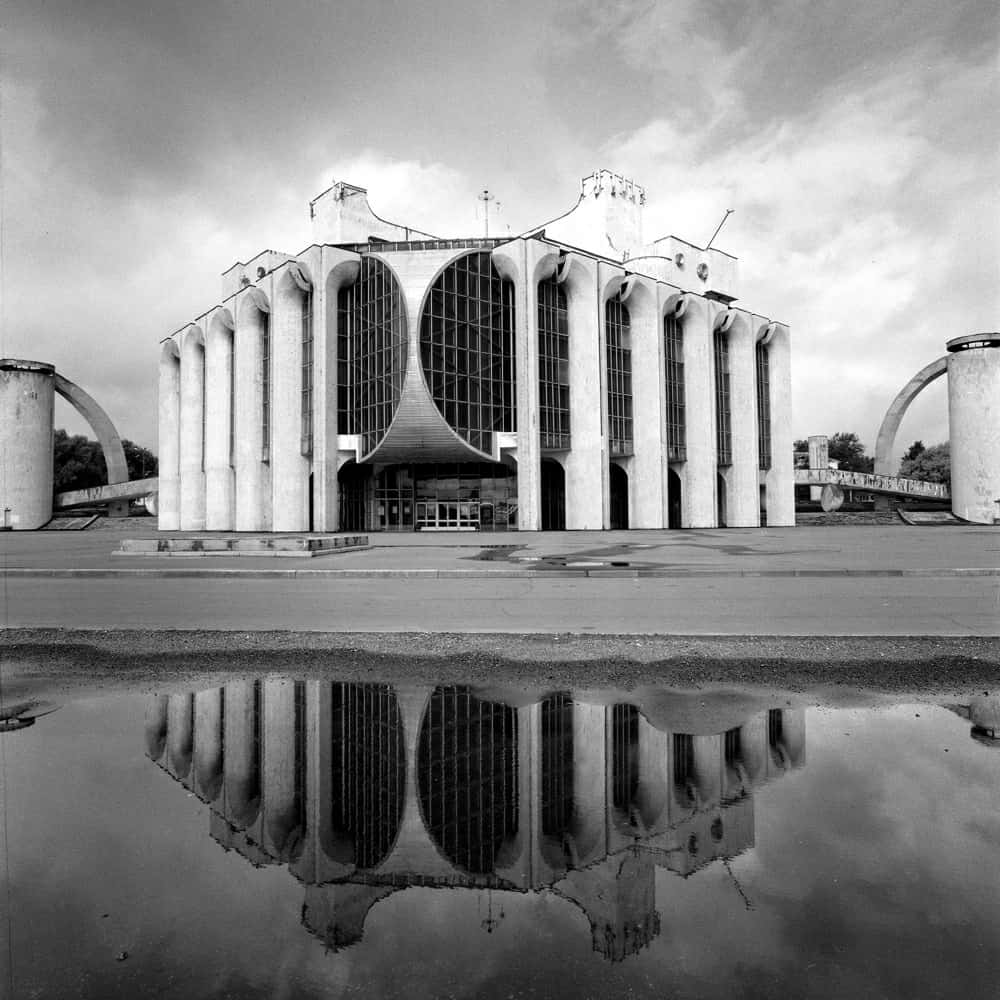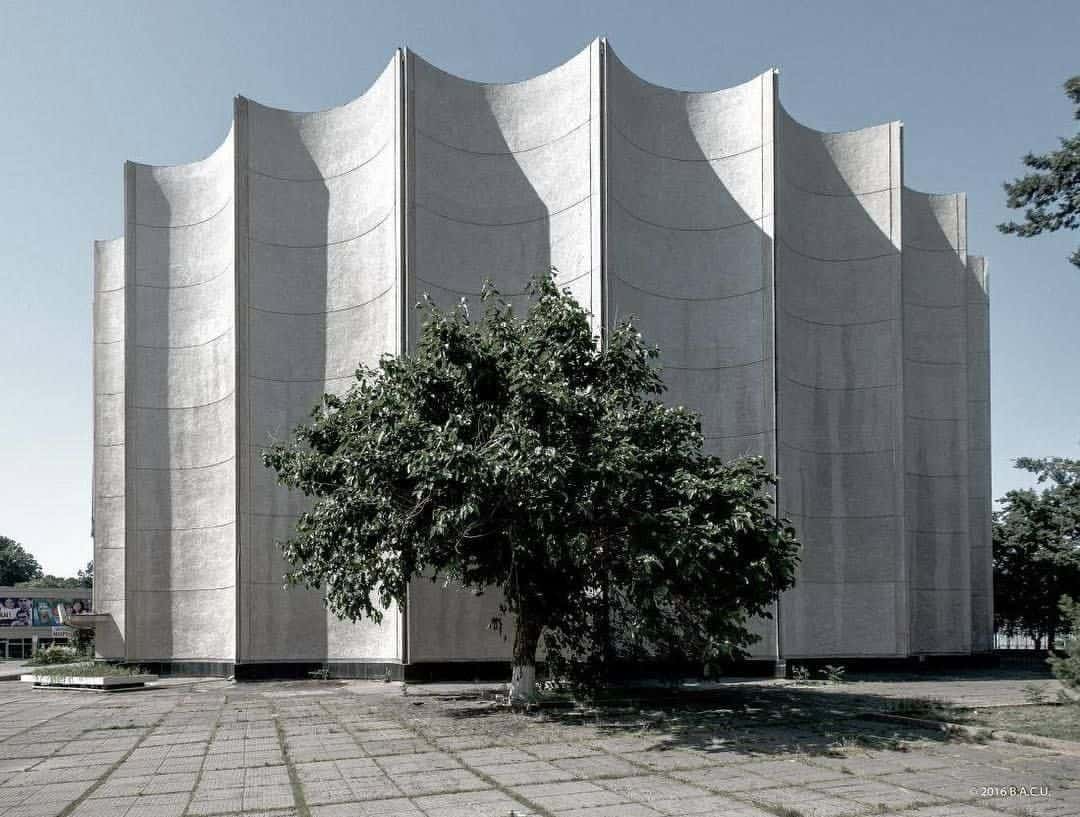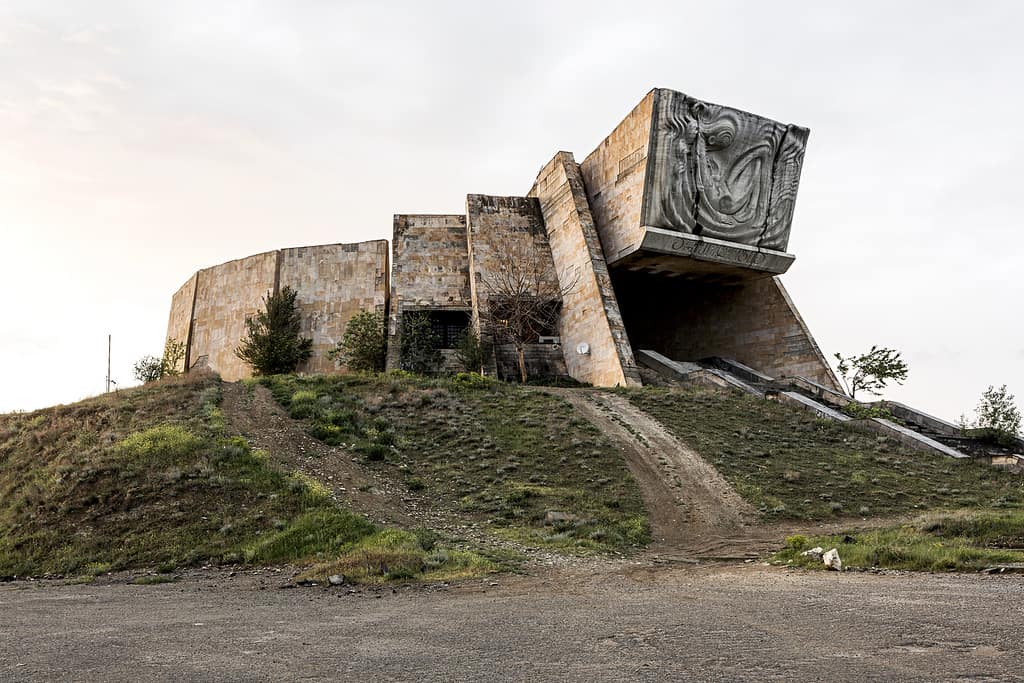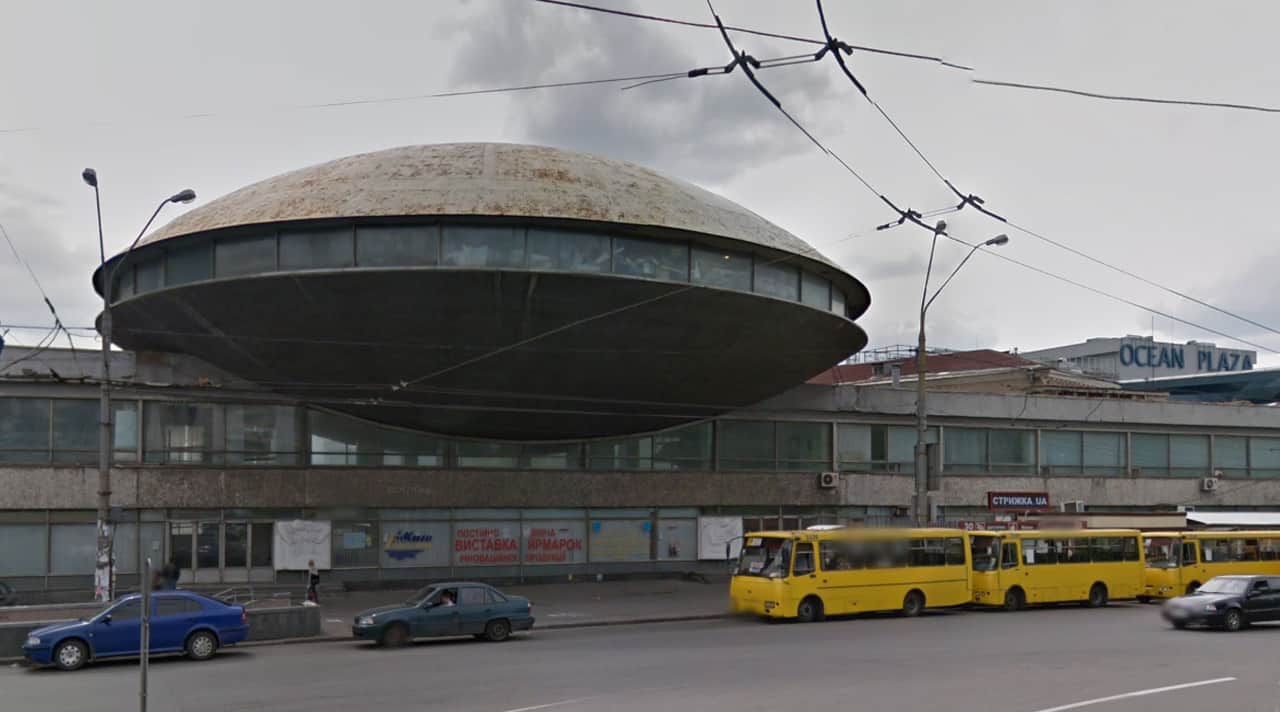Have you ever wondered what would be a perfect Halloween starter pack? Cut-out pumpkins are classic, but you could also follow the new parenting trend of imposing a candy tax on kids’ trick or treat loot to teach them how governments work. Music, as well as lighting, are crucial elements to create an eerie ambience. I would start with playing Baaba & The Fearless Vampire Killers which is an interpretation of Krzysztof Komeda’s compositions taken from Roman Polański’s film The Fearless Vampire Killers. With the stage set (and the appropriate tax imposed), we can comfortably sit and watch a slideshow with horror film set designs, i.e. the oddest edifices created in Eastern Europe.
My selection is based on the book called Cosmic Communist Constructions Photographed by Frédéric Chaubin with images of peculiar Soviet architecture from the late Brezhnev to the final years of the USSR. What has struck me the most was the fact that all of these photographs carry a strong crescendo of mystery. These totalitarian structures were designed to dominate and exert omniscient power over civilians through both spectacular forms and brutalist aesthetics. I wonder how these extravagant buildings came into existence while the State commissioned architectural projects. Looking at them we have a feeling of a powerful form, utopian shape but even precise documentation would not answer all the enigmas. Because of the gaps in their history, they seem to float in a vacuum – like an orphan monument with the nameless architect. Apotheoses in grey, monotony, repetitive models, as well as sci-fi futurism dalliance with monumentalism, were above all political, not aesthetic choices. Evolution of regime shaped the urban landscape significantly. Ease to eliminate the private sector and having no counter-visions has triggered the new chapter of architectural sensibility – resplendent in its monstrosity. Three phases of Soviet architecture (Constructivism, Stalinist sculpture in the round, the Brezhnevian cube) are visually quite apparent. Gregorian architecture professor Vakhtang Davitaia rejected architecture that was mute and of no address – meaning anonymous. His critique on a system that impoverished its heritage of individuals delineates an intriguing punch line. All the cultures are unique and can not be universally Soviet to justify architectural unity. The fact that all of the construction has some dreamlike character might be rooted in speculative novels and movies but also an obsession with cosmos that were a strong part of the Soviet cultural scene. This emergence of fantasy added piquancy, especially to all the unusual structures.
The Fyodor Dostoevsky Theater of Dramatic Art in Veliky Novgorod
At first, I have taken The Fyodor Dostoevsky Theater of Dramatic Art which is a surreal masterpiece by Vladimir Somov, designed to echo the primitive religious architecture of Veliky Novgorod. The theatre was initially created to get the proletariat excited about the arts. Its multi-storey composition and angular elements facade evoke rampage through the worlds of kids’ playground conjunct with a spaceship. Almost impossible constructions are resembling Escheresque hallways and rooms within rooms, the theatre is a phenomenon that few know about, even as it continues to function as an arts hall to this day. An eye-catching bent column with a ladder, which balanced the ensemble, was razed ten years ago because of its use for suicidal purposes.

The Fyodor Dostoevsky Theater of Dramatic Art, Veliky Novgorod, Russian Federation, 1987
Panorama Cinema in Tashkent
We know almost nothing about Panorama Cinema in Tashkent. Despite its evil appearance, this severe windowless building in the centre of Uzbekistan serves a useful and positive purpose. It reminds me of raw American law courts like the Buffalo City Court Building, AT&T Long Lines buildings as well as the skyscrapers in Osaka, Japan. Some researches have shown that productivity inside these monolithic offices is up to 20% higher compared to office buildings with windows. Due to the elimination of outside visual and sonic distractions, a worker is more focused and motivated by the job itself. Supposedly, the cost of removing windows pays for itself in higher productivity. I found an interview with one company president who said that his workers were spending far too much time looking outside and that is why he decided to brick up all the windows. That is a horror scenario happening in real life. Has any additional research mentioned the increase in people with depression?

Panorama Cinema, Tashkent, Uzbekistan, 1970
Former Archaeology Museum in Tbilisi
My attention was also captured by this inconspicuous former Archaeology Museum in Tbilisi with the exhumed body in bas-relief by Tengiz Kikalishvili. The museum was established in 1988 by the Georgian archaeologist, head of the Tbilisi archaeological expedition, Rostom Abramishvili. This secluded structure blends with the surrounding structure and has some similarity with The Mortuary Temple of Hatshepsut in Egypt. Both of them are like shelters emerging from the ground giving the impression that they can plunge back down to hide any minute. Making up conspiracy theories comes naturally when looking at these structures.

Archaeology Museum, Tbilisi, Georgia, 1988
Institute of Scientific and Technical Information in Kiev
Recently, Kiev has refreshed my feelings with faintly mystical and touching perspective on Ukraine’s capital city. I have chosen this destination because of sheer curiosity about their rapidly rising fashion scene. New, hungry generation is reinterpreting tradition into a contemporary fusion of the so-called New East. As far as fashion goes, I have been more surprised by Star Wars looking buildings that seemed grossly out of place. The Institute of Scientific and Technical Information reminds me of an extra-terrestrial unidentified flying object landing and staying until today. Dreaming cosmos is deeply rooted in the society’s mentality says Columbia professor specialising in Soviet architecture Xenia Vytuleva. It has a different edge, so to say. It is also about intimate relationship. Inside the building, I found a deserted public library. Because of construction works I had a chance to see all the hallways stripped down to the concrete core. The dust in the air has covered traces of history. This early 70s saucer can envy the ambition of the Polish architects of Spodek arena in Katowice, opened the same year. A short way away on the bus there is the Vernadsky National Library of Ukraine which immediately terrifies with its scale but also an immense, psychedelic mural called The Pains of the Earth by Volodymyr Pasyvenko and Volodymyr Pryadka. Jack Nicolson (Shinning) would never catch his pray inside this complex structure, while King Minos of Crete at Knossos could lock the Minotaur inside forever. What is interesting is that the library is in possession of Orsha Gospel. The book, which dates back to the late 13th century, is one of the oldest Belarusian texts to depict Cyrillic script.
Along with a dizzying labyrinth, shadows creeping against walls and German Expressionism vibe, the building keeps its weirdness intriguing to the visitor. The last on my list to see was still Hotel Salyut. In the beginning, the project of a skyscraper had the support of the Communist party leadership; however, after the collective refused to add the curator from the party on to the list of authors, the construction project slowly began to decelerate. This is the main reason why the hotel was not completed as initially planned. Nevertheless, its innovative construction stands out in the city’s landscape. Inside along with intimidating silence, there is a spiral descent which might have been inspired by Solomon R. Guggenheim Museum in New York City.

Institute of Scientific and Technical Information, Kiev, Ukraine, 1971

Vernadsky National Library, Kiev, Ukraine, 1918
The Russian State Scientific Center for Robotics and Technical Cybernetics located in St. Petersburg
As an icing on the cake, literally and figuratively, I would like to present The Russian State Scientific Center for Robotics and Technical Cybernetics located in St. Petersburg. This spooky-looking, pointed building dominates over its district. Its soaring structure resembles a spaceship rising into the sky and piercing clouds with its majesty. It’s impossible to stay indifferent.

The Russian State Scientific Center for Robotics and Technical Cybernetics, St. Petersburg, Russia, 1987
On the one hand, the Soviet times left a lot of justified bitterness. But on the other, they bequeathed many valuable cultural works and contributed to the architectural heritage of the 20th century. Not to mention providing perfect spots for a Halloween party.
Written by Marta Klara Sadowska
Edited by Contemporary Lynx
- Vernadsky National Library, Kiev, Ukraine, 1918
- Vernadsky National Library, Kiev, Ukraine, 1918
- Vernadsky National Library, Kiev, Ukraine, 1918
- The Russian State Scientific Center for Robotics and Technical Cybernetics, St. Petersburg, Russia, 1987
- The Russian State Scientific Center for Robotics and Technical Cybernetics, St. Petersburg, Russia, 1987
- The Fyodor Dostoevsky Theater of Dramatic Art, Veliky Novgorod, Russian Federation, 1987
- The Fyodor Dostoevsky Theater of Dramatic Art, Veliky Novgorod, Russian Federation, 1987
- The Fyodor Dostoevsky Theater of Dramatic Art, Veliky Novgorod, Russian Federation, 1987
- Panorama Cinema, Tashkent, Uzbekistan, 1970
- Hotel Salyut, Kiev, Ukraine, 1984
- Hotel Salyut, Kiev, Ukraine, 1984
- Hotel Salyut, Kiev, Ukraine, 1984
- Archaeology Museum, Tbilisi, Georgia, 1988
- Archaeology Museum, Tbilisi, Georgia, 1988
- Archaeology Museum, Tbilisi, Georgia, 1988
- Institute of Scientific and Technical Information, Kiev, Ukraine, 1971
- Institute of Scientific and Technical Information, Kiev, Ukraine, 1971
- Institute of Scientific and Technical Information, Kiev, Ukraine, 1971




























